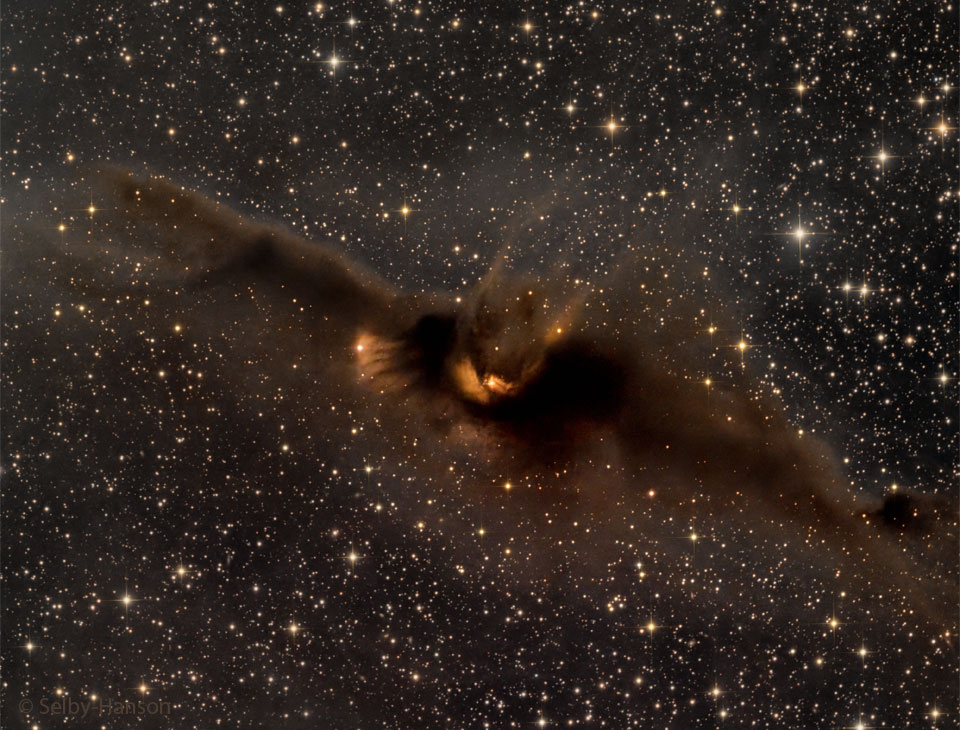
Today’s feature brings you LDN 43, or the Cosmic Bat Nebula. Located in the constellation of Ophiuchus, this dark nebula is a fascinating region filled with mystery and beauty, often overlooked due to its shadowy, starless appearance. Let’s dive into its remarkable characteristics.
Location
LDN 43 resides about 520 light-years away from Earth in the northern constellation Ophiuchus, also known as the Serpent Bearer. This constellation is rich in dark and molecular clouds, making it a hotspot for observing star-forming regions and interstellar dust. The Cosmic Bat Nebula lies near several other dark nebulae within this stellar nursery, contributing to the massive network of interstellar clouds in this region. Due to its location, LDN 43 is best observed from the Northern Hemisphere during the summer months, when Ophiuchus is visible in the night sky.
Structure
The structure of LDN 43 is composed primarily of dense molecular hydrogen, dust, and gas, which effectively block visible light from passing through. This nebula appears as a dark silhouette against a background of brighter stars, creating the shape that resembles a bat with outstretched wings. The dense regions within LDN 43, where the material clumps together under gravity, serve as the perfect conditions for stellar nurseries. These areas are filled with extremely cold gas, which makes it an ideal site for star formation. Deep within these structures, hidden by layers of gas and dust, astronomers have detected protostars in various stages of development.
Importance
The Cosmic Bat Nebula plays a crucial role in understanding the processes behind star formation in dark nebulae. Unlike emission nebulae that glow due to ionized gas, LDN 43’s dark composition gives scientists a unique environment to study how stars are born in the absence of intense radiation. The dense clouds within LDN 43 allow for a slow and controlled collapse of gas and dust, leading to the birth of stars and planetary systems. By observing LDN 43 in wavelengths beyond visible light, such as infrared and radio, scientists gain valuable insights into how interstellar dust and gas accumulate to form stars and even the early building blocks of planets. The nebula’s cold, dense regions help astronomers study the earliest stages of star formation, contributing to our understanding of how cosmic bodies like the Sun might have originated.
Visual Impact
While LDN 43 might not emit light like a colorful emission nebula, its visual impact lies in its shadowy, intricate silhouette. Against the starry backdrop of the Milky Way, the Cosmic Bat Nebula’s dark form creates an enigmatic, almost ghostly image. With long-exposure astrophotography, the nebula’s “bat wings” appear as dark, looming structures, providing a stark contrast to the surrounding stars. This striking appearance has made it a favorite target for photographers who specialize in capturing dark nebulae. The shape of LDN 43—defined by the areas it blocks out rather than the light it emits—gives it a unique, otherworldly beauty that’s rare in the cosmos.
For stargazers and astrophotographers alike, the Cosmic Bat Nebula represents a journey into the hidden regions of space, where beauty is defined by the absence of light. This nebula invites observers to consider the unseen forces of the universe, where darkness creates a canvas for new stars to be born.
Credit
This image was taken by Mark Hanson and Mike Selby.
